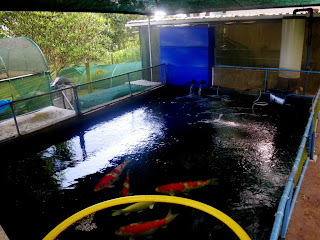Waiting for the koi to clear in Johannesburg- 2 x 1 ton and 2 x 750kg vats with mature pond water brought up from Durban-never mix salt with fresh water!Carry extra water for mixing-the vats must go home completely full so that the water does not "wash" around in the vat.
35 boxes! First seperate the different breeders.
Momotaro koi very well packed and marked.
Open and check koi so that we can unpack any that may not look strong first.Start with the Sakai koi-most valuable and travelled the furthest.
4 bags at a time in a mixing bowl-enough water so that they can swim around.
Open all the bags at the same time.
Add another 2 bags.
Drain off excess travel water,check ph and slowly mix in water from the vat-keep strong oxygen going.Do preliminary check on the koi and photograph any with bumps/bruises to treat later on.
Once the ph has stabilised,move the koi to the transport vat-either by hand or a sock net so that "dirty" water does not transfer across.
At the same time,start the Beppu koi-only 6 boxes so can do them all at the same time-separate mixing bowl/air ring,sock net,etc.
Same procedure.
Stabilise the ph with pond water.
Give them some time to acclimatise.
Carefully put in transport vat.
Once all the fish are safely loaded then we headed back to Durban using 12v Resun air pumps with a generator as a backup.
Once back in Durban 2/3rds of the vat is drained,the ph checked and water from the pond the koi are being put in pumped into the vat.After the koi have acclimatised then the fish are moved from the vat to the pond-separate ponds for different breeders.Above is the pond being used for the Sakai koi-90 tons.
Sakai koi happily settled in.
Momotaro QT pond-20 tons.
Beppu QT pond-20 tons.
Once this shipment was stabilised we arranged for the Ogata koi to be shipped:-
Much simpler with only one breeder.
30 boxes-same procedure.
All safely in QT.






















































